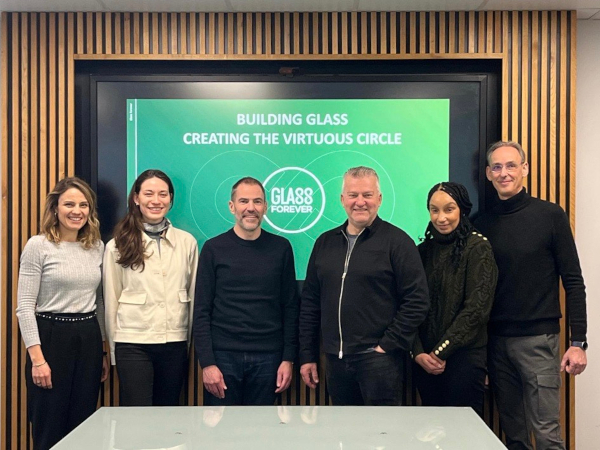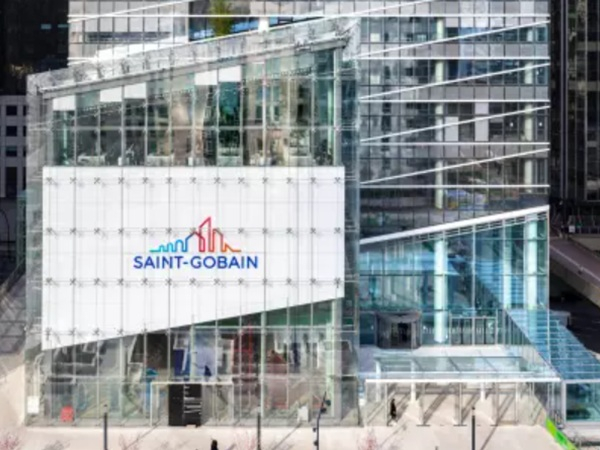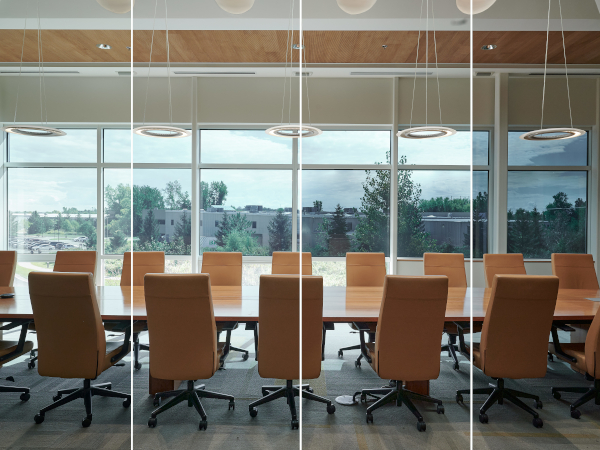Date: 2 February 2007
The Group’s five sectors contributed to this growth, delivering a robust increase in sales on a like-for-like basis (see Appendix 1). The trading environment observed in the first half of the year held firm throughout the six months to end December 2006, with certain business sectors (Flat Glass, Building Distribution) reporting increased momentum in the last few months of the year.
Businesses related to construction markets (in particular Construction Products and Building Distribution) proved buoyant and drove the Group’s growth. In Europe, vigorous construction markets, bolstered by the impact of new European regulations promoting energy efficiency in the construction industry, and in the second half of the year by the recovery of the German market, more than offset the impact of a slowdown in US housing starts. Businesses exposed to household consumption and industrial production markets remained on a growth track.
The Group reported ongoing expansion in Asia and emerging countries, delivering like-for-like growth of 12.7% (14.5% in the second half).
The Flat Glass sector notched up a significant 7.8% rise in sales over the year based on comparable Group structure and exchange rates (11.5% over the six months to December 31, 2006), thanks to the strong second-half recovery of volumes and sales prices on the European construction market, and particularly in Germany. Profitability for the sector improved, to 9.8 in the second half of 2006 (versus 9.4% in second-half 2005), but was slightly down over the full year, due to the first-half impact of the rise in energy and raw materials costs.
High-Performance Materials continued to report sustained like-for-like growth of 3.3% for the full year (2.8% for the second half), reflecting healthy industrial markets, particularly in the energy, environment and housing segments. Ceramics & Plastics and Abrasives scored further gains in profitability, which climbed to 13.0% (versus 12.9% in 2005). However, the operating margin of the Reinforcements business narrowed, hit by another retreat in sales prices, which explains the dip in profitability of the sector as a whole (10.1% of sales compared with 10.5% of sales in 2005).
The Construction Products sector (CP) delivered the Group’s highest organic growth, at 8.7% over the full year (5.8% over the second half), including a 5.8% price impact and a 2.9% volume effect. All of the sector’s businesses contributed to this performance, despite the slowdown in US housing starts in the six months to December 31, 2006. The interior building solutions businesses – Gypsum and Insulation – reported double-digit organic growth for the year (12.1% and 10.4%, respectively), with significant price rises thanks to strong demand on most markets, boosted by a raft of new measures to promote energy efficiency, particularly in Europe. The Pipe division posted 9.6% organic growth, reflecting a strong advance in distant exports and healthy business levels in Europe, mainly France and Spain. Despite the strong organic growth in Industrial Mortars in Europe and emerging countries, the Building Materials division was hit by the impact of a slowdown in US housing starts in the second half of the year, and delivered organic growth of 2.3%. Powered by profitability gains in each of its businesses (except Building Materials in the US), the Construction Products sector reported a sharp increase in profitability to 12.7%, compared with 9.2% in 2005 (or 11.1% proforma including BPB for full-year 2005).
The Building Distribution sector posted a strong increase in like-for-like sales, up 7.0% over the full-year (8.4% over the second half), on the back of a robust trading performance by the sector’s main banners, particularly in France, Scandinavia, eastern Europe, and, for the first time this year, Germany. The sector’s UK banners delivered moderate growth. The Building Distribution business continued with its policy of bolt-on acquisitions in major European countries where it has an operational base. During the year, it acquired 54 companies representing total annual sales of €630 million. Including the contribution to 2006 sales from companies acquired in 2005, the Building Distribution sector posted 6.6% external growth in 2006. Operating income for the sector surged past the symbolic billion-euros mark. Operating margin remained stable at 5.7%, due primarily to the increase in 2006 of development and start-up costs relating to innovative concepts.
Like-for-like sales for the Packaging sector rose 3.6% (over both the full year and over the six months to December 31, 2006), with rising energy and raw materials costs successfully passed on through sales prices in the Bottles & Jars business in the US and in Europe. The sector’s operating margin improved significantly in the second half of the year, to 8.8% versus 8.1% in the second half of 2005, powered chiefly by price rises and improved manufacturing performance.
Analysis of the 2006 consolidated financial statements
Based on the estimates presented at the Board of Directors’ meeting of January 25, 2007, unaudited key consolidated data for 2006 can be viewed by visiting www.saint-gobain.com. The final version of the 2006 consolidated financial statements will be authorized for issue by the Board of Directors at their meeting of March 22, 2007.
Group sales jumped 18.5% on an actual structure basis, and 18.2% at constant exchange rates*. The contribution from acquisitions, net of disposals, represented 11.4% growth. At constant Group structure and exchange rates*, Group sales climbed to €2,519 million, representing like-for-like growth of 6.7% including Gypsum organic growth (12.1%), and of 6.3% excluding Gypsum.
The breakdown of like-for-like sales by geographic area reveals robust trading in France (up 5.7%%) and other western European countries, with the recovery in Germany gathering momentum in the second half of the year (up 11.8%). North America posted moderate growth over the year (up 3.1%), reflecting a dip in housing starts in the six months to December 31, 2006 after a very good first half. Business in emerging countries and Asia remained vigorous, delivering organic growth of 12.7%. By geographic area, France accounted for 28.3% of sales, with other western European countries contributing 42.5%, North America 16%, and emerging countries and Asia/Pacific 13.2%.
Operating income jumped 29.9%, or 29.8% at constant exchange rates*. The Group’s operating margin increased significantly, to 8.9% (10.9% excluding Building Distribution) of sales, versus respectively 8.2% (and 9.8%) in 2005 (excluding BPB), thanks, in particular, to the contribution from the Gypsum business, which reported operating income of €649 million in 2006 (including €50 million in cost synergies), and represented 16.7% of sales. Profitability improved across all geographic areas.
Business income advanced 30.1% due mainly to the increase in operating income. Non operating costs rose to €367 million versus €288 million in 2005, on the back of further restructuring measures designed to maintain the Group’s productivity and competitiveness at optimum levels. Non-operating costs also include a €95 million charge in respect of asbestos-related litigation concerning CertainTeed (€100 million in 2005). Capital gains and losses and exceptional asset write-downs came in at a negative €27 million, versus a negative €21 million in 2005: capital gains on sales of non-current assets in 2006 (€175 million, including €146 million generated on the sale of Calmar) were more than offset by exceptional asset write-downs (€202 million).
Net financial expense advanced 31.5% to €748 million compared with €569 million in 2005, attributable to higher borrowing costs due to the increase in debt following the BPB acquisition. Net income came in at €1,637 million, up 29.5% on 2005. Based on the number of shares making up the capital stock at December 31, 2006 (368,419,723 shares after the creation of 5,399,291 shares for the purposes of the Group Savings Plan, 342,550 shares on the exercise of share subscription options, and 17,421,612 shares further to the conversion of Oceane bonds**), earnings per share jumped 21.3% to €4.44, versus €3.66 in 2005 (based on 345,256,270 shares). Based on the average number of shares (341,048,210 shares in 2006 versus 336,330,568 shares in 2005), earnings per share came in at €4.80 up 27.7% on 2005 (€3.76).
Excluding capital gains and losses, net income surged 32.6% to €1,702 million, compared with €1,284 million in 2005. Based on the number of shares making up the capital stock at December 31, 2006 (368,419,723 shares), earnings per share amounted to €4.62 compared with €3.72 in 2005, a rise of 24.2%. Based on the average number of shares, earnings per share came in at €4.99, up 30.6% on 2005 (€3.82).
Cash flow from operations stands at €3,347 million, up 22.4% year-on-year. Excluding the tax impact of capital gains and losses, cash flow from operations increased 23.6% to €3,374 million, versus €2,730 million in 2005.
Capital expenditure advanced 24.8% to €2,191 million (5.3% of sales, or 4.5% excluding BPB), against €1,756 million in 2005 (5.0% of sales). This rise was mainly fuelled by the integration of BPB – where higher year-on-year capital expenditure (proforma) represented 12.5% of sales. Saint-Gobain continues to invest heavily in emerging countries and Asia, which accounted for 27.1% of the Group’s total capital expenditure.
Investments in securities amounted to €584 million, including €355 million relating to Building Distribution and €142 million relating to Construction Products.
Net debt after the dividend payout, collection of the proceeds from the Calmar sale (€568 million) and conversion of the Oceane bonds** (€915 million), stood at €11,599 million at December 31, 2006, down 9.7% on the year-earlier figure (€12,850 million). Net debt also includes an exceptional payment of €672 million to fund pension schemes, of which €518 million in Germany. Net debt represents 80% of consolidated shareholders’ equity, versus 104.4% at December 31, 2005.
* based on average exchange rates for 2005
** bonds convertible and/or exchangeable into new or existing shares
Update on asbestos claims in the United States
Some 7,000 claims were filed against CertainTeed in 2006, down 59% on 2005 (17,000 claims). At the same time, around 12,000 claims were resolved (compared with 20,000 in 2005), and 19,000 claims were transferred to “inactive dockets” further to a number of court rulings in the States of Ohio and Texas. The number of outstanding claims therefore continued on a downward trend, falling to around 76,000 at end-December 2006 versus 100,000 at December 31, 2005. Total damages paid in 2006 amounted to USD 83 million (compared with USD 88 million in 2005). The average cost per claim settled in the past 12 months or in the process of settlement at December 31, 2006 was around USD 3,000 per claim, up slightly on the year-earlier figure (around USD 2,800 per claim), due to the lower proportion of mass actions settled over the last 12 months as a proportion of total claims settled.
In light of these trends, an additional provision of €95 million was recorded in 2006 (versus €100 million in 2005), increasing the total coverage for CertainTeed’s asbestos-related claims to approximately USD 451 million at December 31, 2006, compared with USD 422 million at end- December 2005.
On the legislative front, the likelihood of a vote on federal reform in the short or medium term now appears to be almost nil. However, numerous States continue to consider tort reform measures in order to adopt medical criteria requirements and reduce abuses of the system.
Strategy
The Group’s strong results in 2006 highlight the efficiency of its business model and the high-quality acquisition of BPB, which posted better-than-expected operating results, was integrated successfully within the Group, and unlocked cost synergies ahead of term. The BPB acquisition is strongly accretive (impact of 15% on net income excluding capital gains and losses).
The Group intends to focus its strategy on:
- prioritizing development of construction, housing, and energy-related businesses, in particular through bolt-on acquisitions in Building Distribution and Construction Products sectors;
- pushing ahead with R&D and innovation initiatives, particularly in Flat Glass and High-Performance Materials sectors;
- stepping up expansion efforts in emerging countries.
Accordingly, after the 2006 sales of Calmar and Synflex, the Group began a strategic review of the Reinforcements & Composites business (with a plan to create a joint venture with Owens Corning) and of Saint-Gobain Desjonquères, for which it is currently looking to find partners. Positive developments suggest that a deal could be reached in the next few weeks, based on an enterprise value of around €690 million. Part of this amount will be used by Saint-Gobain to take a 20% stake in the capital of the new company. The transaction is subject to discussions with the corresponding employee representative bodies.
In 2007, the Group will consider further measures aimed at reorganizing its businesses in line with its business model, and growth and profitability potential.
2007 outlook and targets
The Group expects the economic climate to remain favorable in most markets (with the exception of
new residential construction in the US), and for 2007 is targeting:
- robust growth in operating income at constant exchange rates (based on average exchange rates for 2006);
- double-digit growth in net income, excluding capital gains and losses on sales of non-current assets.
These objectives are based on the assumption that both Saint-Gobain Desjonquères and the Reinforcements & Composites business will be deconsolidated in first-half 2007, but do not reflect any other major scope adjustments that may occur in 2007.












Add new comment